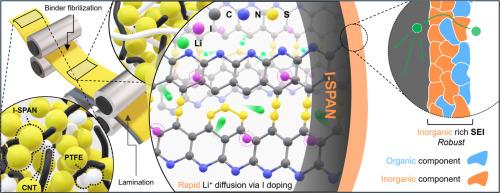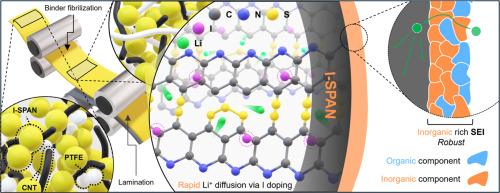Harnessing iodine doping to unlock high-loading SPAN dry-electrode for practical Li–S batteries
IF 20.2
1区 材料科学
Q1 CHEMISTRY, PHYSICAL
引用次数: 0
Abstract
Sulfurized polyacrylonitrile (SPAN) is a promising cathode material for high-loading lithium–sulfur batteries owing to its inherent ability to suppress the shuttle effect. However, they undergo severe volume changes during cycling. Fabrication of dry electrodes can mitigate this issue by providing structural integrity and mechanical robustness while enabling high-loading electrodes without binder migration or conductive material aggregation due to the elimination of solvent evaporation. Despite these advantages, the nonpolar nature of the polytetrafluoroethylene (PTFE) binder limits Li+ affinity and ion transport. Herein, we introduce an iodine-doped SPAN (I-SPAN), in which the incorporation of iodine creates an electron-rich environment that enhances Li+ adsorption and diffusion. The dissolution of iodine into the electrolyte triggers nucleophilic substitution with PF6–, forming a LiF/LiI-rich cathode–electrolyte interphase (CEI) that lowers the interfacial resistance and improves structural stability. Consequently, solvent-free I-SPAN dry electrodes with 90 wt% active material deliver an areal capacity of 22.6 mAh cm-2 at a loading of 42.4 mgAM cm-2 and a rate of 0.05 A gAM-1. In addition, at a loading of 8.8 mgAM cm-2, the dry electrode maintained a reversible capacity of approximately 4.0 mAh cm-2 even at a high current density 0.5 A gAM-1.


利用碘掺杂解锁用于实用锂电池的高负载SPAN干电极
硫化聚丙烯腈(SPAN)由于其固有的抑制穿梭效应的能力,是一种很有前途的高负荷锂硫电池正极材料。然而,它们在循环过程中会经历剧烈的体积变化。干电极的制造可以通过提供结构完整性和机械稳健性来缓解这一问题,同时由于消除了溶剂蒸发,使得高负载电极没有粘合剂迁移或导电材料聚集。尽管有这些优点,聚四氟乙烯(PTFE)粘合剂的非极性性质限制了Li+的亲和力和离子传输。在此,我们引入了一种碘掺杂的SPAN (I-SPAN),其中碘的掺入创造了一个富电子环境,增强了Li+的吸附和扩散。碘溶解到电解质中触发与PF6-1的亲核取代,形成富锂/富锂的阴极-电解质界面相(CEI),降低界面阻力,提高结构稳定性。因此,含90 wt%活性物质的无溶剂I-SPAN干电极在负载为42.4 mgAM cm-2和速率为0.05 a gAM-1时的面容量为22.6 mAh cm-2。此外,在8.8 mgAM cm-2的负载下,即使在0.5 a gAM-1的高电流密度下,干电极也能保持约4.0 mAh cm-2的可逆容量。
本文章由计算机程序翻译,如有差异,请以英文原文为准。
求助全文
约1分钟内获得全文
求助全文
来源期刊

Energy Storage Materials
Materials Science-General Materials Science
CiteScore
33.00
自引率
5.90%
发文量
652
审稿时长
27 days
期刊介绍:
Energy Storage Materials is a global interdisciplinary journal dedicated to sharing scientific and technological advancements in materials and devices for advanced energy storage and related energy conversion, such as in metal-O2 batteries. The journal features comprehensive research articles, including full papers and short communications, as well as authoritative feature articles and reviews by leading experts in the field.
Energy Storage Materials covers a wide range of topics, including the synthesis, fabrication, structure, properties, performance, and technological applications of energy storage materials. Additionally, the journal explores strategies, policies, and developments in the field of energy storage materials and devices for sustainable energy.
Published papers are selected based on their scientific and technological significance, their ability to provide valuable new knowledge, and their relevance to the international research community.
 求助内容:
求助内容: 应助结果提醒方式:
应助结果提醒方式:


